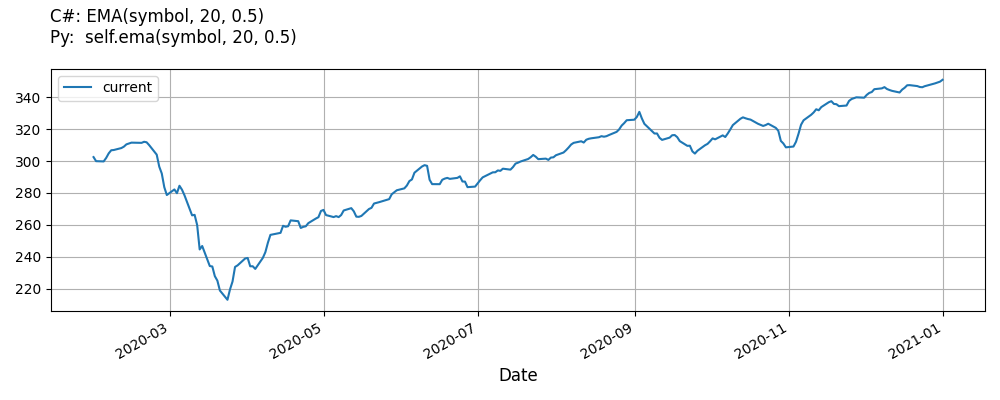Supported Indicators
Exponential Moving Average
Introduction
This indicator represents the traditional exponential moving average indicator (EMA). When the indicator is ready, the first value of the EMA is equivalent to the simple moving average. After the first EMA value, the EMA value is a function of the previous EMA value. Therefore, depending on the number of samples you feed into the indicator, it can provide different EMA values for a single security and lookback period. To make the indicator values consistent across time, warm up the indicator with all the trailing security price history.
To view the implementation of this indicator, see the LEAN GitHub repository.
Using EMA Indicator
To create an automatic indicator for ExponentialMovingAverage, call the EMAema helper method from the QCAlgorithm class. The EMAema method creates a ExponentialMovingAverage object, hooks it up for automatic updates, and returns it so you can used it in your algorithm. In most cases, you should call the helper method in the Initializeinitialize method.
public class ExponentialMovingAverageAlgorithm : QCAlgorithm
{
private Symbol _symbol;
private ExponentialMovingAverage _ema;
public override void Initialize()
{
_symbol = AddEquity("SPY", Resolution.Daily).Symbol;
_ema = EMA(_symbol, 20, 0.5m);
}
public override void OnData(Slice data)
{
if (_ema.IsReady)
{
// The current value of _ema is represented by itself (_ema)
// or _ema.Current.Value
Plot("ExponentialMovingAverage", "ema", _ema);
}
}
} class ExponentialMovingAverageAlgorithm(QCAlgorithm):
def initialize(self) -> None:
self._symbol = self.add_equity("SPY", Resolution.DAILY).symbol
self._ema = self.ema(self._symbol, 20, 0.5)
def on_data(self, slice: Slice) -> None:
if self._ema.is_ready:
# The current value of self._ema is represented by self._ema.current.value
self.plot("ExponentialMovingAverage", "ema", self._ema.current.value)For more information about this method, see the QCAlgorithm classQCAlgorithm class.
You can manually create a ExponentialMovingAverage indicator, so it doesn't automatically update. Manual indicators let you update their values with any data you choose.
Updating your indicator manually enables you to control when the indicator is updated and what data you use to update it. To manually update the indicator, call the Updateupdate method. The indicator will only be ready after you prime it with enough data.
public class ExponentialMovingAverageAlgorithm : QCAlgorithm
{
private Symbol _symbol;
private ExponentialMovingAverage _exponentialmovingaverage;
public override void Initialize()
{
_symbol = AddEquity("SPY", Resolution.Daily).Symbol;
_exponentialmovingaverage = new ExponentialMovingAverage(20, 0.5m);
}
public override void OnData(Slice data)
{
if (data.Bars.TryGetValue(_symbol, out var bar))
_exponentialmovingaverage.Update(bar.EndTime, bar.Close);
if (_exponentialmovingaverage.IsReady)
{
// The current value of _exponentialmovingaverage is represented by itself (_exponentialmovingaverage)
// or _exponentialmovingaverage.Current.Value
Plot("ExponentialMovingAverage", "exponentialmovingaverage", _exponentialmovingaverage);
}
}
} class ExponentialMovingAverageAlgorithm(QCAlgorithm):
def initialize(self) -> None:
self._symbol = self.add_equity("SPY", Resolution.DAILY).symbol
self._exponentialmovingaverage = ExponentialMovingAverage(20, 0.5)
def on_data(self, slice: Slice) -> None:
bar = slice.bars.get(self._symbol)
if bar:
self._exponentialmovingaverage.update(bar.end_time, bar.close)
if self._exponentialmovingaverage.is_ready:
# The current value of self._exponentialmovingaverage is represented by self._exponentialmovingaverage.current.value
self.plot("ExponentialMovingAverage", "exponentialmovingaverage", self._exponentialmovingaverage.current.value)For more information about this indicator, see its referencereference.
Indicator History
To get the historical data of the ExponentialMovingAverage indicator, call the IndicatorHistoryself.indicator_history method. This method resets your indicator, makes a history request, and updates the indicator with the historical data. Just like with regular history requests, the IndicatorHistoryindicator_history method supports time periods based on a trailing number of bars, a trailing period of time, or a defined period of time. If you don't provide a resolution argument, it defaults to match the resolution of the security subscription.
public class ExponentialMovingAverageAlgorithm : QCAlgorithm
{
private Symbol _symbol;
private ExponentialMovingAverage _ema;
public override void Initialize()
{
_symbol = AddEquity("SPY", Resolution.Daily).Symbol;
_ema = EMA(_symbol, 20, 0.5m);
var indicatorHistory = IndicatorHistory(_ema, _symbol, 100, Resolution.Minute);
var timeSpanIndicatorHistory = IndicatorHistory(_ema, _symbol, TimeSpan.FromDays(10), Resolution.Minute);
var timePeriodIndicatorHistory = IndicatorHistory(_ema, _symbol, new DateTime(2024, 7, 1), new DateTime(2024, 7, 5), Resolution.Minute);
}
} class ExponentialMovingAverageAlgorithm(QCAlgorithm):
def initialize(self) -> None:
self._symbol = self.add_equity("SPY", Resolution.DAILY).symbol
self._ema = self.ema(self._symbol, 20, 0.5)
indicator_history = self.indicator_history(self._ema, self._symbol, 100, Resolution.MINUTE)
timedelta_indicator_history = self.indicator_history(self._ema, self._symbol, timedelta(days=10), Resolution.MINUTE)
time_period_indicator_history = self.indicator_history(self._ema, self._symbol, datetime(2024, 7, 1), datetime(2024, 7, 5), Resolution.MINUTE)
